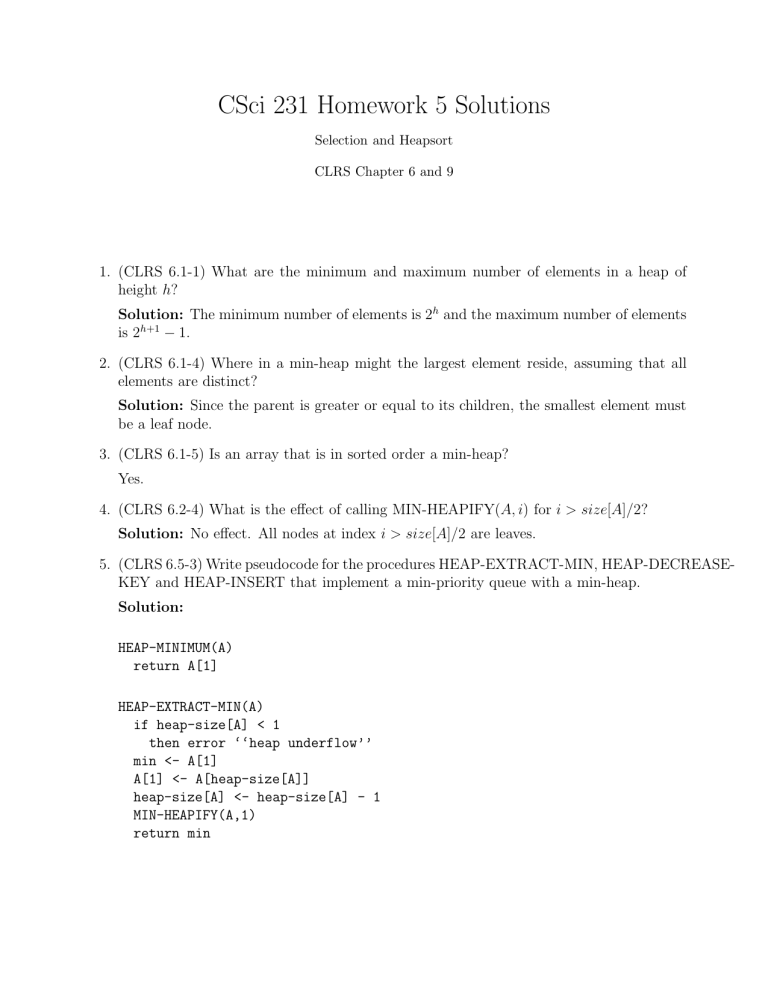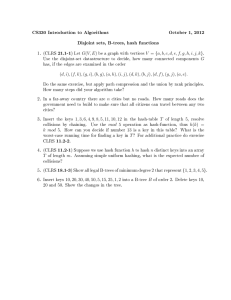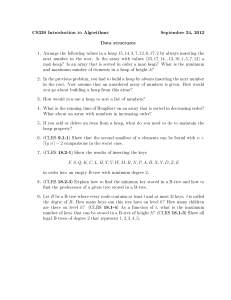CSci 231 Homework 5 Solutions

CSci 231 Homework 5 Solutions
Selection and Heapsort
CLRS Chapter 6 and 9
1. (CLRS 6.1-1) What are the minimum and maximum number of elements in a heap of height h ?
Solution: The minimum number of elements is 2 h is 2 h +1
−
1.
and the maximum number of elements
2. (CLRS 6.1-4) Where in a min-heap might the largest element reside, assuming that all elements are distinct?
Solution: Since the parent is greater or equal to its children, the smallest element must be a leaf node.
3. (CLRS 6.1-5) Is an array that is in sorted order a min-heap?
Yes.
4. (CLRS 6.2-4) What is the effect of calling MIN-HEAPIFY( A, i ) for i > size [ A ] / 2?
Solution: No effect. All nodes at index i > size [ A ] / 2 are leaves.
5. (CLRS 6.5-3) Write pseudocode for the procedures HEAP-EXTRACT-MIN, HEAP-DECREASE-
KEY and HEAP-INSERT that implement a min-priority queue with a min-heap.
Solution:
HEAP-MINIMUM(A) return A[1]
HEAP-EXTRACT-MIN(A) if heap-size[A] < 1 then error ‘‘heap underflow’’ min <- A[1]
A[1] <- A[heap-size[A]] heap-size[A] <- heap-size[A] - 1
MIN-HEAPIFY(A,1) return min
HEAP-DECREASE-KEY(A,i,key) if key > A[i] then error ‘‘new key is larger than current key’’
A[i] <- key while i > 1 and A[parent(i)] > A[i] do exchange A[i] <-> A[parent(i)] i <- parent(i)
MIN-HEAP-INSERT(A,key) heap-size[A] <- heap-size[A] + 1
A[heap-size[A]] <- +inf
HEAP-DECREASE-KEY(A,heap-size[A],key)
6. (CLRS 6.5-8) Give an O ( n lg k )-time algorithm to merge k sorted lists into one sorted list, where n is the total number of elements in all the input lists. ( Hint: use a min-heap for k -way merging .)
Solution: The straightforward solution is to pick the smallest of the top elements in each list, repeatedly. This takes k
−
1 comparisons per element, in total O ( k
· n ).
As the hint suggests, the idea for the “improved” solution is to keep the smallest element from each list in a heap; each element is augmented with the index of the lists where it comes from. We can perform a DeleteMin on the heap to find and delete the smallest element and insert the next element from the corresponding list.
Analysis: It takes O ( k ) to build the heap; for every element, it takes O (lg k ) to DeleteMin and O (lg k ) to insert the next one from the same list. In total it takes O ( k + n lg k ) =
O ( n lg k ).
7. (CLRS 9.3-6) Give an O ( n lg k ) algorithm to find the k
−
1 elements in a set that partition the set into (approx.) k equal-sized sets A
1
, A
2
, . . . A k such that all elements in A i are smaller than all elements in A i +1
.
Solution: For simplicity, assume that k is a power of 2.
k-PARTITION(A, p, r, k) if k > 1 then q = SELECT(A, (p+r)/2) output q k-PARTITION(A, p, (p+r)/2, k/2) k-PARTITION(A, (p+r)/2+1, r, k/2)
End.
Analysis: T ( n, k ) = 2 T ( n/ 2 , k/ 2) + Θ( n ), and T ( n/k, 1) = 1 has solution T ( n ) =
Θ( n lg k ).
2
8. (CLRS 9-1) Given a set of n numbers, we wish to find the i largest in sorted order using a comparison-based algorithm. Find the algorithm that implements each of the following methods with the best asymptotic worst-case running time, and analyze the running times of the algorithms on terms of n and i .
(a) Sort the numbers, and list the i largest.
Solution: Use Mergesort, or Quicksort with median as pivot. It takes O ( n lg n ) to sort and O ( i ) to list, in total O ( n lg n ).
(b) Build a max-priority queue from the numbers, and call EXTRACT-MAX i times.
Solution: Building a heap takes O ( n ), and EXTRACT-MAX costs O (lg n ). In total this algorithm takes O ( n + i lg n ).
(c) Use a SELECT algorithm to find the i th largest number, partition around that number, and sort the i largest numbers.
Solution: This takes O ( n ) to select the i th largest and partition around it, and
O ( i lg i ) to sort, in total O ( n + i lg i ).
3


